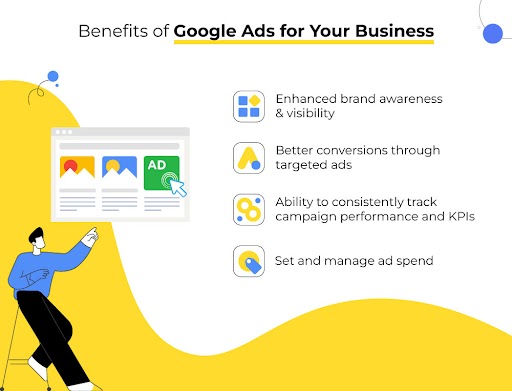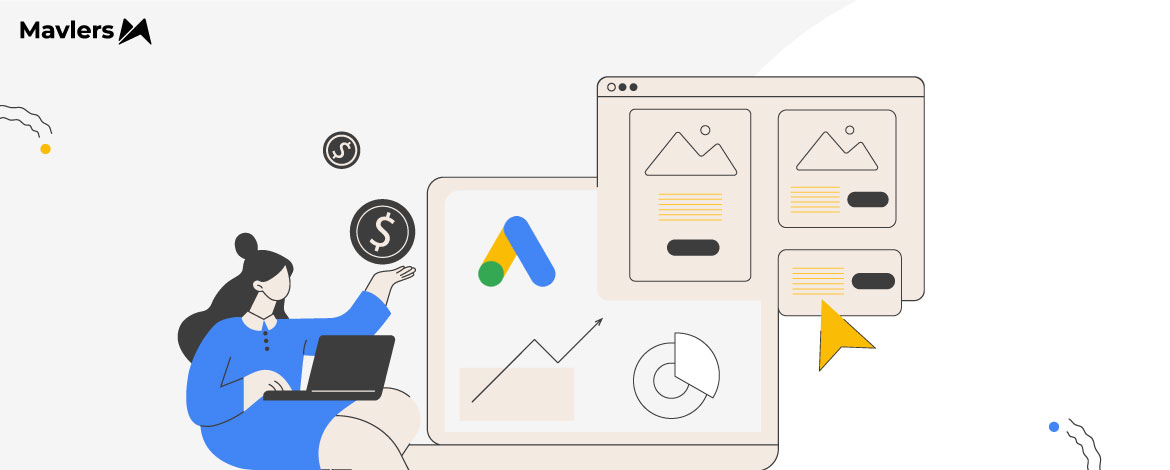As a brand owner or seasoned marketer, you are always looking for ways to get better organic reach, more sales-qualified leads ready to make a purchase, and ways to drive the right traffic to your website/landing pages.
But the truth is, it is not that simple, and you might have caught yourself thinking about investing in paid advertising campaigns to garner targeted views, clicks, and ultimately better ROIs.
If you are sailing in a similar boat, you might be seeking honest answers to questions like,
- How can Google Ads help advance your business?
- What are the different types of Google Ads?
- How can you make Google Ads more effective for your business?
We at Mavlers have successfully helped 6000+ brands and agencies meet their business goals through customized digital marketing services. With twelve years of experience, we decided to pen down honest and unbiased answers to the above concerns.
By the end of this blog, you will stand to gain clarity on how to grow your business with Google Ads, Google Ads benefits, and ways to optimize them so that you can realize maximum return on ad spend (ROAS).
How can Google Ads help advance your business?
In this section, we will try to dissect the benefits of running business ads on Google in as much detail as possible.
1. The ability to track/measure advertising performance consistently
You don’t want to be pumping money in a leaky ship! Setting up Google Ads conversion tracking mechanisms such as GA4 analytics and adding Google Tag Manager to your website will help you stay updated on what’s working and what needs to be fixed.
With the conversion tracking mechanism in place, you can not only track key performance indicators, such as when someone clicked on your ad, made a visit to a product page, downloaded your app, or made a purchase, but also use these metrics to optimize your ad campaigns and copies for better results!
Here are some areas where your business can benefit from consistent tracking,
- Monitoring lead inflow and sales: You can track campaign effectiveness by monitoring data on events like newsletter sign-ups, click-throughs, and purchases that can, in turn, give better insights into the top-performing campaigns, ads, and keywords, facilitating better ad spend decisions.
- Optimized ROI reporting: This plays a key role in campaign profitability assessment by identifying campaigns performing well and those needing adjustments to draw better traffic and ROAS.
- Identify best ad creatives: By making the most of the Google Ads testing facility, you can see what goes down well with your target audience and those that need to be done away with. By regular iteration, you can optimize headlines, ad copies, images, and CTAs for maximum return on your investment.
- Carry out keyword analysis: The success of an ad campaign depends heavily on the choice of relevant keywords. Continuous tracking and evaluation can help you optimize your keyword list to focus on the high-performing ones that rope in the ROI!
2. Enhance brand awareness & visibility through targeted ads
There is a famous saying in the world of marketers, which goes something like when you sell to everyone, you are reaching no one!
Yep! That saying holds its weight worth in gold!
Google advertising for small businesses enables them to target the audience that is actually interested in their product/service. This helps them build awareness and brand visibility to a larger, more relevant audience.
Here’s how you can make your ads more targeted:
- Bidding on the relevant keywords
- Setting up the right ad locations, such as Google Search & Display networks
- Choose the demographics, geographic location, and language of your target audience
- Set up the days, time and frequency of your ad campaigns
- Select devices on which your ads will be displayed, or you can choose all, such as desktop, mobile, tablet, etc.
3. Maximize conversions by bringing in qualified leads & sales
If you are looking to generate better leads and on-site conversions, then Google Ads are the perfect way to go! They prompt direct action through ads, such as directing prospective customers to deals, offers, gated content, and other consumer touchpoints.
Checkout the Google Ads campaign types for achieving enhanced conversions,
- Search campaigns: These work well for consumers actively searching for relevant keywords. You can use responsive search ads or call-only ads to strike when and where the iron is hot, resulting in relevant audiences taking direct action.
- Shopping campaigns: These highly visual Google Ads campaigns can be a boon for the e-commerce business. They display the product price, images, and specs, fostering direct sales from those with a high buying intent.

- Video campaigns (Skippable and non-skippable in-stream): Video ads can be a great format for explaining your product or service USP lucidly, thereby driving both qualified leads and sales. While non-skippable ads on platforms such as YouTube ensure that your message gets delivered, the skippable ones reel in interested audiences.
- P-Max or Performance Max campaigns: If you are one of those businesses aiming to drive maximum results from all of Google’s networks, this could be your best bet. It relies on Google’s machine learning to automate and optimize your ads across placements and drive maximum conversions. You can read all about it in our blog here.
- App campaigns: If your business has a downloadable app and you want to increase your app’s user base, then this is the way to go!
- Remarketing display campaigns: This one can target those individuals who have visited your website yet have not made a purchase. Since they have already shown interest in your business, these display remarketing apps can bring them back to make a purchase or fill out a lead form.
- Local services ads: This is a boon for those “near me” searches! If you are a local business targeting audiences in a set geographical locale, then this can be used to invite queries from interested local leads who spot your ads at the top of search results.
Now that we are familiar with the benefits of Google Ads for your business let’s dive into the different kinds of Google Ads you might want to explore.

What are the different types of Google Ads?
Your business advertising goals and requirements must be crystal clear before you decide to settle for a specific type of Google ad or maybe choose to mix and match with multiple campaigns. Here’s an insight into the kinds of Google Ads on offer:
1. Search Ads: They appear on SERPs (Search Engine Results Pages) when users search for relevant keywords related to your business. Chargeable on a cost-per-click (CPC) basis, you pay only when someone clicks on your ad.
2. Display Ads: This refers to the visual ads that appear on websites, videos, and apps within the Google Display Network. You can choose to pay either on a CPC or CPM (cost per mile) basis. Want to know more about the difference between the two payment models? Read our blog here.
3. Video Ads: These are skippable or non-skippable ads that run before, during, or after YouTube videos or on other partner websites. They can be charged on the basis of CPE (cost-per-engagement) or CPV (cost-per-view).
4. Shopping Ads: Great for e-commerce businesses. Visual product ads with images, descriptions, and prices pop up in the Shopping tab. These are chargeable on a CPC basis.
5. App Ads: For businesses looking to increase their app user base on Google Play, the App Store, and other platforms, this one can be a good fit. They can be charged on a CPA (cost-per-action) or CPI (cost-per-install) basis.
6. Local Ads: Great for local businesses seeking audiences searching for relevant services in a limited geographic area. They can be charged on a CPC or CPA basis.
Having gained familiarity with the kinds of Google Ads and their benefits for your business, let’s now shift gears toward tips and tricks on optimizing your ad campaigns.
How can you make Google Ads more effective for your business?
If you are wondering how to get maximum results from your ad campaigns with minimum spending, the following tips should help you do that without costing you an arm and a leg.
1. Set clear advertising goals: To achieve the ROI you want, you need to align your advertising budget and goals with your business’s goals. The campaign type will be influenced by the objectives that you have in mind.
Are you looking for greater brand visibility? Or more conversions? Or just more sign-ups? Depending on your business journey, having clear answers to questions like these can help you make a better advertising decision.
2. Build a decent campaign structure: Invest a good amount of time in setting up your ad campaigns, from conducting detailed keyword research to setting up events, ad groups, and targeted locations. These efforts are bound to pay off in the end.
3. Focus on getting high-quality scores: Google reviews your ad copy, landing page relevancy, keywords, and bid amount and assigns a Quality Score. High-quality scores translate into better rankings and, ultimately, higher chances of conversions. The idea is to set up ads that direct people to what they seek.
4. Optimize your landing pages: Once the user clicks on your ad and reaches the intended landing page, only to be disappointed by what’s on offer, you can expect the rankings to drop. You can fix this by optimizing your landing page and offering the promised value in return for their click. And no, you don’t need to add the Google Ad’s logo to the homepage when designing for advertising.
5. Focus on long tail keywords: Instead of targeting generic keywords like “shoes,” try more specific ones such as “running shoes for women” or “Shoe shops for men near me.” You get the drift; be more specific with your keywords, highlighting the product or the location.
What’s next?!
Phew! That’s a whole lot of information to take in! So, if you plan to build your next Google Ads campaign, you could do that or let experts handle it all for you!
Looking forward to assisting you with all your Google Ads campaign management needs! Semper Fi! 🙂


Naina Sandhir - Content Writer
Latest posts by Naina Sandhir - Content Writer (see all)
How Mavlers Avoid Misaligned Expectations During Projects
Why Does Digital Marketing Offshoring Fail?